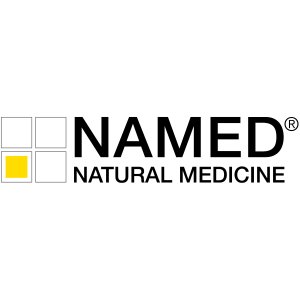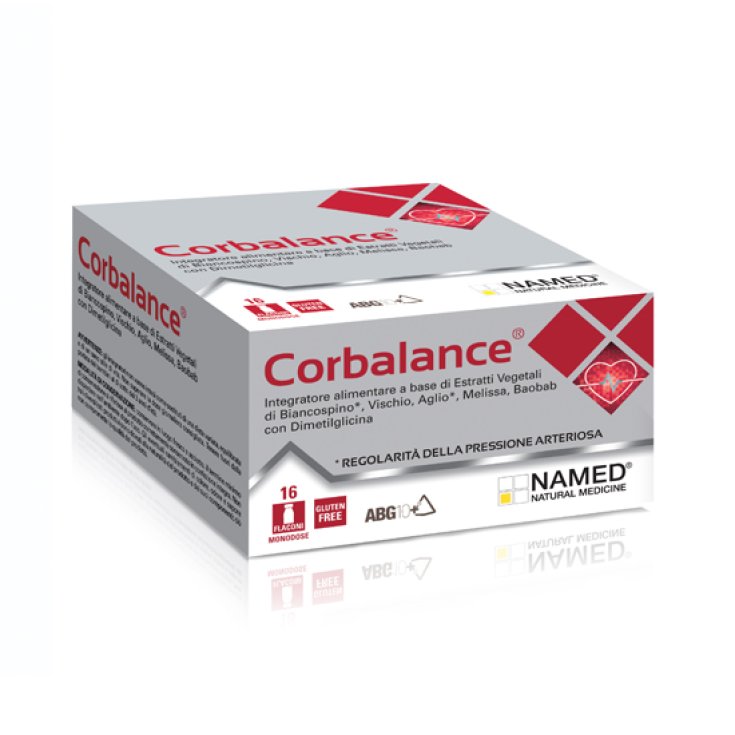Corbalance Named 16 Bottles

- Brand: NAMED Srl
- Product Code: 973912266
- EAN: 8058269350352
- Availability: In 10 - 14 Days
- Purchase 3 items for 13.62€ each
- Purchase 4 items for 13.34€ each
- Purchase 5 items for 13.07€ each
Corbalance Named Food Supplement
Corbalance is a supplement with Garlic and Hawthorn which are useful for the regularity of blood pressure and the functionality of the cardiovascular system. Lemon balm contributes to relaxation and mental well-being. Mistletoe has an antioxidant function.
HOW TO USE
We recommend taking 1 vial (15 ml) per day.
GLUTEN FREE
INFORMATION ON THE INDIVIDUAL COMPONENTS OF CORBALANCE®
Hawthorn : promotes the regular function of the cardiovascular system, especially blood pressure. It acts as an antioxidant and promotes relaxation and mental well-being.
Garlic : promotes the metabolism of triglycerides and cholesterol, together with hawthorn it is indicated for cardiovascular well-being, it also acts as an antioxidant. The extract of dried black garlic ABG10 + (Aged Black Garlic) is obtained through a production process that eliminates the unpleasant organoleptic characteristics attributable to allicin, while keeping all the bioactive compounds unaltered.
Mistletoe : Mistletoe leaves promote lipid metabolism and act as antioxidants.
Baobab : called by the Africans the Magic Tree, the Pharmacist Tree and the Tree of Life, this immense and powerful symbol of Africa is useful for the regularity of blood pressure, carries out a support and restorative action. Promotes the body's natural defenses.
Lemon balm : its leaves, rich in essential oil which gives the plant a pleasant aroma and lemon flavor, are used to promote relaxation, mental well-being and a normal mood. It is indicated for digestive functions and gastrointestinal well-being. It also has an antioxidant action.
Dimethylglycine : produced in mammalian cells by the catabolism of choline and betaine. The dimethylglycine produced can be involved in various enzymatic reactions or be used for the production of numerous secondary metabolites such as glycine, serine, and a number of carbon units which can be in various oxidation states. Dimethylglycine can also be involved in the processes of methylation and transmethylation, useful in cases of resynthesis of the various constituents of the cells, for example the conversion of homocysteine into methionine.
Hypertension (high blood pressure) is one of the most common medical conditions, affecting people of all ages. However, the inability to "feel" hypertension or its effects on the heart, in terms of overwork, makes it difficult to bring and keep the situation under control. In fact, when blood pressure is too high and stabilizes at high values, over time it can damage the arteries and internal organs: kidneys, heart, brain and eyes. Part of the damage caused by high blood pressure is the thickening of the endothelium of the artery. When this happens, it is easier for fat and cholesterol to settle on the artery walls, eventually blocking them. Arterial pressure is regulated by numerous factors, through extremely complex mechanisms in dynamic equilibrium between them. The main factor that determines blood pressure is the volume of blood in the arteries: an increase in blood volume results in an increase in blood pressure and, conversely, a decrease in volume produces a decrease in pressure. The pressure levels are, in fact, determined both by the cardiac output (quantity of blood pumped by the heart) and by the vascular resistances that the blood encounters along the circulatory path. In addition to nervous and chemical factors, mechanical factors also affect cardiac output, including the amount of blood found in the heart at the end of diastole (cardiac dilatation). Peripheral vascular resistances are represented by the friction that occurs between the blood and the vessel walls. This friction develops both for the characteristics of the blood (viscosity) and for the reduction of the diameter of the vascular lumen. The viscosity of the blood depends on the presence of red blood cells and other protein and lipid molecules. An increase in their blood concentration causes an increase in blood viscosity and, consequently, an increase in peripheral resistance. Furthermore, thanks to their muscular wall, the vessels can contract or relax and, in parallel, increase or decrease blood pressure. In this way, the amount of blood that passes from the arteries to the arterioles and to the respective parts of the body supplied by them is also controlled. Hence, the greater the resistance opposed by arterioles to the blood flow, the greater the volume of blood that remains in the arteries and, consequently, the higher the blood pressure. Other mechanisms are involved in the regulation of blood pressure; in the walls of the blood vessels there are in fact receptors that transmit to the Central Nervous System information on changes in pressure and on changes in concentrations of carbon dioxide, oxygen and blood pH. Therefore, an individual's pressure levels vary continuously in relation to his physical state and environmental circumstances. For example, muscle activity, intellectual effort, emotional arousal increase the pressure, as does exposure to cold, while with the summer heat the pressure tends to decrease. Generally, blood pressure tends to rise with age. The daily pressure trend is not constant: the values are maximum during the morning, fall in the early afternoon, rise in the evening and lower again during the night, reaching minimum values in the early morning.
When hypertension is mild, it can be kept under control with some precautions: exercise (at least 20 minutes, 3 times a week), weight control, reduction of fat and salt in one's diet, increased consumption of fruit and vegetables. For 80% of hypertensive people, however, diet and physical exercise are not always sufficient, it is therefore necessary to act in a more meaningful and targeted way to restore and maintain values within the norm.
Ingrediants
Water, Fructose, Aqueous extracts concentrated in the ratio D / E1 1: 2 of Hawthorn [(Crataegus laevigata Poir.) DC.] Flowering tops and Mistletoe (Viscum album L.) aerial parts, Baobab (Adansonia digitata L.) pulp of the fruit powder, Dimethylglycine, Flavors, Lemon balm (Melissa officinalis L.) essential oil, ABG10 + ® [Black Garlic (Allium sativum L.) bulb eg tit. 0.1% in S-allylcysteine (SAC)], Preservative: potassium sorbate.
1) D / E = drug / extract ratio.
Allergens contained: none.
| COMPOSITION | |
| Average contents | 15 ml (max dose / day) |
| Hawthorn ea * | 1125 mg |
| equal to flowering tops | 562.5 mg |
| Mistletoe ea * | 1125 mg |
| equal to aerial parts | 562.5 mg |
| Baobab powder | 500 mg |
| Dimethylglycine | 200 mg |
| Melissa oe ** | 100 mg |
| ABG10 + ® (Black garlic) eg | 50 mg |
| Supply in S-allyl-cysteine (SAC) | 0.05 mg |
* ea = concentrated aqueous extract
** oe = essential oil
Format
Pack with 16 single-dose vials of 15ml.

